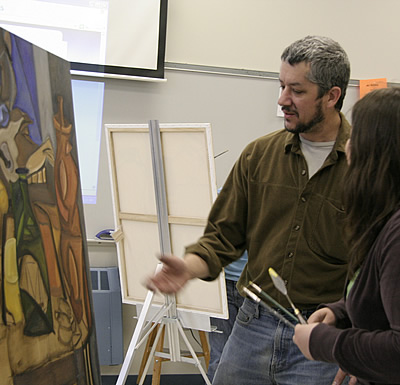
January 5 - February 23 (no class 2/9), 2019
Saturdays
10am - 1pm
7 weeks
Instructor: Steve DiGiovanni
Instructor's website
Fee: $225
Discover a world of color and light by learning the basics of painting from observation. Instruction will cover everything from material properties and the palette, to the principles of color mixing, paint handling and composition. Emphasis will be placed on learning to “see” color and form objectively. Some drawing experience is recommended.
Steven DiGiovanni is a professional artist and instructor who lives and works in New Haven, Connecticut. He has exhibited throughout the region and is included in numerous private collections as well as the New Britain Museum of American Art.
He has completed portraits for the Yale University department of political science, the Yale school of medicine and other private and professional clients. His work and exhibitions have been reviewed in many publications including the New York Times and Art New England.
Steven currently teaches locally at the Creative Arts Workshop in New Haven, where he is the head of the Drawing and Painting Department, and as an adjunct professor at Norwalk Community College in Norwalk, CT.
GENERAL OIL AND ACRYLIC MATERIALS LIST
Students may choose either oil or acrylic media to complete the course (See “Notes” below)
RECOMMENDED COLORS: Recommend “medium” or “artist” grade color in acrylics.
Student Grade colors acceptable for oils. Difference is in pigment quality, tinting strength and covering ability.
Cadmium Red Medium (hue)
Cadmium Yellow Light (hue)
Yellow Ochre
Burnt Sienna
Raw Umber
Ultramarine Blue
Titanium or Zinc White (large tube)
OPTIONAL COLORS
Alizarin Crimson
Viridian green
Cerulean or Manganese Blue
any Violet
MEDIUMS (OIL ONLY):
Turpenoid (blue can only) or other ODORLESS thinner
2oz. Liquin or Galkyd Medium
(ACRYLIC ONLY)
4oz. Polymer Medium (Matte or Gloss)
1 tube Retarding Medium
A spray mister is recommended to keep palette and painting surface wet.
SUGGESTED BRUSHES AND TOOLS (any variety of sizes and shapes will do)
Oil and acrylic brushes are long handled. White bristle and synthetic brushes are least expensive
Flat (long, square cut) natural white bristle 3/4”
Filbert (flat, round cut) sable or synthetic ½”
Round sable #4 or #6
Sash (Chinese bristle “house painting” brush) 2” or 3”
3” or 4” Spatula type Palette Knife (not “Painting Knife” with round stem)
Blade should be flexible and not rigid. Be sure to check that it bends along the blade and not at the handle
14”X18” MINIMUM Palette (disposable sheets, wood or plexiglass)
12”X16” (or similar size) pad Canvas Paper
paper towels
masking tape
Notes on the Paints:
Students are free to choose between oil and acrylic media.
Oil paint is the more traditional medium. It is bound with linseed, or similar oils and thinned with turpentine and/or mineral spirits. It retains the brush mark, is very flexible, easy to blend and dries relatively slowly: 24 hours to several days for some colors.
For those that are sensitive to solvents, water-based oils are an option. They retain many of the handling characteristics of traditional oils, yet are less toxic and easier to clean up. They are not yet available in as wide a variety of colors as regular oils.
For those that are sensitive and prefer to use oil color, disposable rubber gloves are recommended.
Acrylic paint is generally less expensive. Acrylic colors are water based and dry fairly rapidly. Retarding, or acrylic glazing, medium may be used to extend the drying time. Acrylic does not retain the texture of the brush mark as effectively as oil, and blending effects can be difficult to achieve. Acrylic is available in a wide variety of densities and can be mixed with a broad variety of acrylic polymer mediums. Matching mixed colors can be difficult as the acrylic dries darker than when it is mixed and applied.
Paints are available in “professional” and “student” grades.
Student grade oils are recommended for those on a tight budget. They often use less costly “substitute” pigments and/or possess less pigment strength. They generally perform as well as professional grade colors.
Student grade acrylics – Liquitex Basics, Soho Urban Artist, Artist’s Loft colors should be avoided. Their performance characteristics (spread-ability, opacity) are far inferior to the artist’s grade color and can frustrate, rather than enable, the intentions of the student artist.
